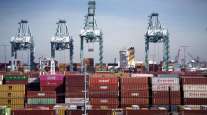Senior Reporter
Most of the Nation’s Ports Report Strong July

[Stay on top of transportation news: Get TTNews in your inbox.]
Most of the nation’s largest seaports are reporting record cargo volume amid stalled trade negotiations between the United States and China.
The Port of Los Angeles, the nation’s busiest, set a new single-month cargo record for the fourth consecutive month. In July, it moved 912,154 20-foot equivalent units (TEUs), marking the busiest July in its 112-year history. That’s a 9.4% jump from 833,567 TEUs the year before.
“Despite the continued decline in exports and high level of uncertainty driven by trade tensions, we continue to optimize our facilities and are grateful for the support and confidence of our supply chain partners,” said Gene Seroka, executive director of Port of Los Angeles.
At nearby Port of Long Beach, longshoremen processed 621,780 TEUs in July, a drop in volume of 9.7% compared with 688,457 in July 2018.
#POLB cargo volumes last month were down 9.7% from the previous July, when the number of containers moved through the harbor neared 700,000 TEUs. Executive Director Mario Cordero: "Trade war is hitting the West Coast hard."https://t.co/lWS9Fi2zk4 pic.twitter.com/OT2HsSLix8 — Port of Long Beach (@portoflongbeach) August 12, 2019
Port officials attributed the drop to retailers having already shipped goods in order to beat the tariffs imposed by Washington and Beijing.
“Most of the cargo containers moving through the Port of Long Beach are either coming from or going to China, so the trade dispute between the U.S. and China is having the effect of reducing cargo volumes at the port,” spokesman Lee Peterson said, adding that more than half of the $200 billion annual cargo is with Chinese companies.
The Port of Oakland processed 218,191 TEUs compared with 217,363 last year.
Some 90,598 of the July containers were imports, making it the busiest month for imported cargo in the port’s 92 year history.
“This is the fourth time import volume has increased in the past five months,” said John Driscoll, maritime director at Port of Oakland.
Economist Rajeev Dhawan, director of the Economic Forecasting Center at Georgia State University in Atlanta, said that late summer and early fall is the time when shippers begin gearing up for the Christmas holiday shopping season, and they’re beginning to move items now.
“If you announce far in advance about tariffs, the shippers can adjust. If you just say we’re going to put up the tariffs with just 15 days notice, then they won’t be able to do it,” said Dhawan.
The Northwest Seaport Alliance, which runs operations at the ports of Seattle and Tacoma, Wash., said TEUs were flat in July compared with the same month last year. The port processed 326,515 last month and 327,462 a year ago, a difference of 947.
NWSA handles record international container volumes through July https://t.co/KnGGSaVS5D — The Northwest Seaport Alliance (@SeaportNW) August 20, 2019
On the East Coast, the Port of Savannah kicked off fiscal year 2020 in July, processing 387,024 TEUs compared with 378,767 in the same month last year. (Savannah wrapped up fiscal year 2019 on June 30, having moved a record 4.5 million TEUs, a 7% increase from 2018.)
“Our ports are firing on all cylinders,” Georgia Gov. Brian Kemp said.
The South Carolina Port Authority said July was a record as it processed 210,542 TEUs compared with 200,594 in the same month last year for an increase of 4.9%.
The Port of Houston processed 259,993 TEUs in July compared with 236,032 last year, or a 10.1% increase.
Year-to-date the Houston facility is up 12%, at 1,721,402 TEUs through the end of July compared with 1,542,191 in 2018.
A port official told Transport Topics a surge in the shipment of plastic resin, a byproduct of the petrochemical industry, is one of the main reasons for the increase.
The Port of Virginia processed 265,559 TEUs in July, compared with 252,679 in the same period last year. The strong cargo performance was driven by an increase of more than 4% in loaded import containers, and a jump of nearly 18% in empty export containers, which are being repositioned across the globe to handle peak-season cargo.
“Many of the empty export containers will come back to Virginia as import loads full of consumer goods for the coming retail season,” said port CEO John Reinhart.




